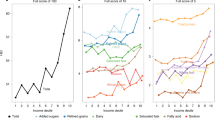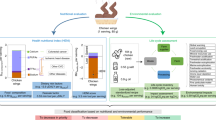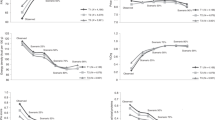Abstract
Our recognition of the environmental pressures associated with dietary patterns has grown considerably over the past decade. However, few studies have analysed the impacts associated with the consumption of ultra-processed food (UPF) and which steps in the food chain contribute the most. Here, using a representative sample of French adults (2,121 enrolled in the Third French Individual and National Food Consumption survey), we investigate the environmental pressures of diets according to UPF consumption. Food intakes were analysed to define the %UPF by weight in the diet according to the NOVA food-classification system. Using detailed environmental data from Agribalyse, we assessed the contribution of UPF to 14 environmental pressure indicators and the contributions of the different food chain stages to these impacts: production, processing, storage, packaging, transport and retailing. The data were described according to quintiles of %UPF in the diet and analysed using crude and energy-adjusted models. Overall, UPF represented 19% of the diet yet contributed 24% to the diet’s greenhouse gas emissions, 23% to water use, 23% to land use and 26% to energy demand. Compared with low consumers of UPF (quintile 1; median UPF, 7%), high consumers (quintile 5; median UPF, 35%) consumed more caloric energy (+22%). Caloric intake partially explained the higher environmental pressures from high-UPF consumers. After we adjusted for calories consumed, the associations with greenhouse gas emissions and land use vanished, and the associations with water use and energy demand became negative. However, the processing and packaging stages contributed significantly to energy demand. Post-farm stages, such as final-product creation and packaging, contributed greater environmental impacts of UPF-rich diets.
This is a preview of subscription content, access via your institution
Access options
Access Nature and 54 other Nature Portfolio journals
Get Nature+, our best-value online-access subscription
$29.99 / 30 days
cancel any time
Subscribe to this journal
Receive 12 digital issues and online access to articles
$119.00 per year
only $9.92 per issue
Buy this article
- Purchase on Springer Link
- Instant access to full article PDF
Prices may be subject to local taxes which are calculated during checkout


Similar content being viewed by others
Data availability
The data described in the manuscript will be made available upon request pending application and approval to collaboration@etude-nutrinet-sante.fr.
Code availability
The code book and analytic code will be made available upon request pending application and approval to collaboration@etude-nutrinet-sante.fr.
References
Lindgren, E. et al. Sustainable food systems—a health perspective. Sustain. Sci. 13, 1505–1517 (2018).
Baker, P. et al. Ultra-processed foods and the nutrition transition: global, regional and national trends, food systems transformations and political economy drivers. Obes. Rev. 21, e13126 (2020). Dec.
Willett, W. et al. Food in the Anthropocene: the EAT-Lancet Commission on healthy diets from sustainable food systems. Lancet 393, 447–492 (2019).
Srour, B. & Touvier, M. Ultra-processed foods and human health: what do we already know and what will further research tell us? EClinicalMedicine 32, 100747 (2021).
Salomé, M. et al. Contrary to ultra-processed foods, the consumption of unprocessed or minimally processed foods is associated with favorable patterns of protein intake, diet quality and lower cardiometabolic risk in French adults (INCA3). Eur. J. Nutr. 60, 4055–4067 (2021).
Monteiro, C. A. et al. The UN Decade of Nutrition, the NOVA food classification and the trouble with ultra-processing. Public Health Nutr. 21, 5–17 (2018).
Taneri, P. E. et al. Association between ultra-processed food intake and all-cause mortality: a systematic review and meta-analysis. Am. J. Epidemiol. 191, 1323–1335 (2022).
Suksatan, W. et al. Ultra-processed food consumption and adult mortality risk: a systematic review and dose–response meta-analysis of 207,291 participants. Nutrients 14, 174 (2021).
Jardim, M. Z., Costa, B. V. d. L., Pessoa, M. C. & Duarte, C. K. Ultra-processed foods increase noncommunicable chronic disease risk. Nutr. Res. 95, 19–34 (2021).
Delpino, F. M. et al. Ultra-processed food and risk of type 2 diabetes: a systematic review and meta-analysis of longitudinal studies. Int. J. Epidemiol. 51, 1120–1141 (2022).
Moradi, S. et al. Ultra-processed food consumption and adult diabetes risk: a systematic review and dose–response meta-analysis. Nutrients 13, 4410 (2021).
Dicken, S. J. & Batterham, R. L. The role of diet quality in mediating the association between ultra-processed food intake, obesity and health-related outcomes: a review of prospective cohort studies. Nutrients 14, 23 (2021).
Chen, X. et al. Consumption of ultra-processed foods and health outcomes: a systematic review of epidemiological studies. Nutr. J. 19, 86 (2020).
Clark, M. A., Springmann, M., Hill, J. & Tilman, D. Multiple health and environmental impacts of foods. Proc. Natl Acad. Sci. USA 116, 23357–23362 (2019).
Nutrition and Food Systems Report No. 12 (High Level Panel of Experts on Food Security and Nutrition of the Committee on World Food Security, 2017).
Crippa, M. et al. Food systems are responsible for a third of global anthropogenic GHG emissions. Nat. Food 2, 198–209 (2021).
Poore, J. & Nemecek, T. Reducing food’s environmental impacts through producers and consumers. Science 360, 987–992 (2018).
da Silva, J. T. et al. Greenhouse gas emissions, water footprint, and ecological footprint of food purchases according to their degree of processing in Brazilian metropolitan areas: a time-series study from 1987 to 2018. Lancet Planet. Health 5, e775–e785 (2021).
Vellinga, R. E. et al. Evaluation of foods, drinks and diets in the Netherlands according to the degree of processing for nutritional quality, environmental impact and food costs. BMC Public Health 22, 877 (2022).
Seferidi, P. et al. The neglected environmental impacts of ultra-processed foods. Lancet Planet. Health 4, e437–e438 (2020).
Garzillo, J. M. F. et al. Ultra-processed food intake and diet carbon and water footprints: a national study in Brazil. Rev. Saude Publica 56, 6 (2022).
Anastasiou, K., Baker, P., Hadjikakou, M., Hendrie, G. A. & Lawrence, M. A conceptual framework for understanding the environmental impacts of ultra-processed foods and implications for sustainable food systems. J. Clean. Prod. 368, 133155 (2022).
Barré, T. et al. Integrating nutrient bioavailability and co-production links when identifying sustainable diets: how low should we reduce meat consumption? PLoS ONE 13, e0191767 (2018).
Hadjikakou, M. Trimming the excess: environmental impacts of discretionary food consumption in Australia. Ecol. Econ. 131, 119–128 (2017).
Lemaire, A. & Limbourg, S. How can food loss and waste management achieve sustainable development goals? J. Clean. Prod. 234, 1221–1234 (2019).
Fresán, U. & Sabaté, J. Vegetarian diets: planetary health and its alignment with human health. Adv. Nutr. 10, S380–S388 (2019).
Fardet, A. & Rock, E. Ultra-processed foods and food system sustainability: what are the links? Sustainability 12, 6280 (2020).
Clark, M., Hill, J. & Tilman, D. The diet, health, and environment trilemma. Annu. Rev. Environ. Resour. 43, 109–134 (2018).
Vieux, F., Darmon, N., Touazi, D., Soler, L. & Soler, L. G. Greenhouse gas emissions of self-selected individual diets in France: changing the diet structure or consuming less? Ecol. Econ. 75, 91–101 (2012).
Hendrie, G. A., Baird, D., Ridoutt, B., Hadjikakou, M. & Noakes, M. Overconsumption of energy and excessive discretionary food intake inflates dietary greenhouse gas emissions in Australia. Nutrients 8, E690 (2016).
Aceves-Martins, M. et al. Nutritional quality, environmental impact and cost of ultra-processed foods: a UK food-based analysis. Int. J. Environ. Res. Public Health 19, 3191 (2022).
Notarnicola, B., Tassielli, G., Renzulli, P. A., Castellani, V. & Sala, S. Environmental impacts of food consumption in Europe. J. Clean. Prod. 140, 753–765 (2017).
Li, D., Wang, X., Chan, H. K. & Manzini, R. Sustainable food supply chain management. Int. J. Prod. Econ. 152, 1–8 (2014).
Leite, F. H. M. et al. Ultra-processed foods should be central to global food systems dialogue and action on biodiversity. BMJ Glob. Health 7, e008269 (2022).
Vieux, F., Soler, L. G., Touazi, D. & Darmon, N. High nutritional quality is not associated with low greenhouse gas emissions in self-selected diets of French adults. Am. J. Clin. Nutr. 97, 569–583 (2013).
Tilman, D. & Clark, M. Global diets link environmental sustainability and human health. Nature 515, 518–522 (2014).
Swinburn, B. A. et al. The global syndemic of obesity, undernutrition, and climate change: the Lancet Commission report. Lancet 393, 791–846 (2019).
Gehring, J. et al. Consumption of ultra-processed foods by pesco-vegetarians, vegetarians, and vegans: associations with duration and age at diet initiation. J. Nutr. 151, 120–131 (2021).
AGRIBALYSE 3.0, the French Agricultural and Food LCI Database, Methodology for Food Products (ADEME, 2020); https://doc.agribalyse.fr/documentation-en/agribalyse-data/documentation
Dubuisson, C. et al. The Third French Individual and National Food Consumption (INCA3) Survey 2014–2015: method, design and participation rate in the framework of a European harmonization process. Public Health Nutr. 22, 584–600 (2019).
Sautory, O. INSEE: La Macro CALMAR-Redressement d’un Échantillon par Calage sur Marges (INSEE, 1993); http://www.insee.fr/fr/methodes/outils/calmar/doccalmar.pdf
Aglago, E. K. et al. Evaluation of the international standardized 24-h dietary recall methodology (GloboDiet) for potential application in research and surveillance within African settings. Glob. Health 13, 35 (2017).
French Food Composition Table (CIQUAL) (ANSES, 2012), http://www.afssa.fr/TableCIQUAL
Monteiro, C. A. et al. Ultra-processed foods: what they are and how to identify them. Public Health Nutr. 22, 936–941 (2019).
Srour, B. et al. Ultraprocessed food consumption and risk of type 2 diabetes among participants of the NutriNet-Santé prospective cohort. JAMA Intern. Med. 180, 283–291 (2020).
Chaltiel, D. et al. Programme National Nutrition Santé—Guidelines Score 2 (PNNS-GS2): development and validation of a diet quality score reflecting the 2017 French dietary guidelines. Br. J. Nutr. 122, 331–342 (2019).
de Gavelle, E., Huneau, J. F. & Mariotti, F. Patterns of protein food intake are associated with nutrient adequacy in the general French adult population. Nutrients 10, 226 (2018).
Colomb, V. et al. AGRIBALYSE: the French public LCI database for agricultural products. ResearchGate https://doi.org/10.13140/RG.2.1.2586.0240 (2015).
Guidance for the Development of Product Environmental Footprint Category Rules (PEFCRs)—Version 6.3 (European Commission, 2018); https://ec.europa.eu/environment/eussd/smgp/pdf/PEFCR_guidance_v6.3.pdf
Koch, P. & Salou, T. AGRIBALYSE: Rapport Méthodologique—Volet Agriculture—Version 3.0 (ADEME, 2020); www.ademe.fr/agribalyse-en
Willett, W. C. Nutritional Epidemiology 3rd edn (Oxford Univ. Press, 2012).
SAS Institute Inc. SAS/ACCESS 9.4 Interface to ADABAS. Cary, NC, SAS Institute Inc. (2013).
R Core Team. R: A language and environment for statistical computing. R Foundation for Statistical Computing, Vienna, Austria. https://www.R-project.org (2022).
Acknowledgements
We thank V. Colomb and M. Cornélius (ADEME) for their support in the use of the Agribalyse database.
Author information
Authors and Affiliations
Contributions
E.K.-G. conducted the research, implemented the databases, conducted the analyses and wrote the manuscript. All authors critically helped in the interpretation of the results, revised the manuscript and provided relevant intellectual input. They all read and approved the final manuscript. E.K.-G. had primary responsibility for the final content; she is the guarantor.
Corresponding author
Ethics declarations
Competing interests
F.M. was the scientific leader of a PhD project funded until October 2021 in part by a research contract with Terres Univia, the French Interbranch organization for plant oils and proteins. This funding has no link with the present work. The other authors declare no competing interests.
Peer review
Peer review information
Nature Sustainability thanks Jacqueline Da Silva, Paraskevi Seferidi and Reina Vellinga for their contribution to the peer review of this work.
Additional information
Publisher’s note Springer Nature remains neutral with regard to jurisdictional claims in published maps and institutional affiliations.
Supplementary information
Supplementary Information
Supplementary Methods 1–3, Tables 1–4 and Figs. 1–3.
Rights and permissions
Springer Nature or its licensor (e.g. a society or other partner) holds exclusive rights to this article under a publishing agreement with the author(s) or other rightsholder(s); author self-archiving of the accepted manuscript version of this article is solely governed by the terms of such publishing agreement and applicable law.
About this article
Cite this article
Kesse-Guyot, E., Allès, B., Brunin, J. et al. Environmental impacts along the value chain from the consumption of ultra-processed foods. Nat Sustain 6, 192–202 (2023). https://doi.org/10.1038/s41893-022-01013-4
Received:
Accepted:
Published:
Issue Date:
DOI: https://doi.org/10.1038/s41893-022-01013-4
This article is cited by
-
Potential unexpected effects of meat reduction in diet: Could educational attainment influence meat substitution strategies?
Agricultural and Food Economics (2024)
-
Water is life, water is food
Nature Food (2023)



